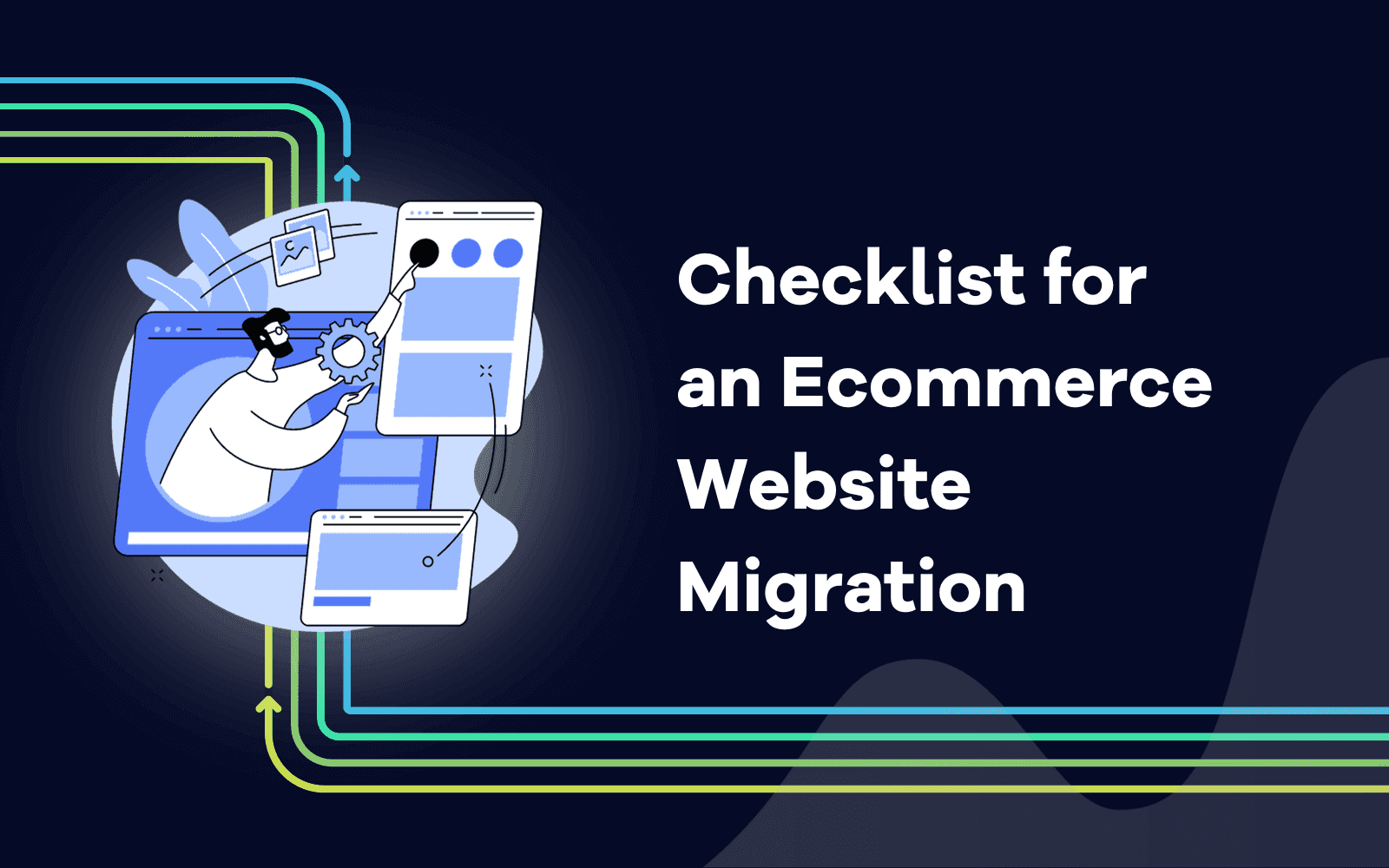Checklist for an Ecommerce Website Migration
Last updated on Wednesday, November 1, 2023

Growing or scaling up your business can be joyful and disheartening at the same time, especially when it calls for adapting to “the best in the market”. The level of pressure is pretty immense. Right from the pressure of dealing with unnecessary employees, to feeling overwhelmed by the evolving demands of the end-users, unwanted breakdowns, slowdowns, lost revenues—the list never ends.
Now there are times when it seems like your business has outgrown itself, especially in regards to its current platform. So what to do? Well, it's quite simple. You need to move on and look out for ways to up your game? In other words, it is time to migrate your eCommerce store properly. Fret not, the following post focuses on the true significance of eCommerce website migration and of course, what is required to conduct a successful eCommerce website migration.
Migrating an ecommerce store is not much different from migrating a regular store, however, the only issue is that a lot of your time and money is at stake. Also, there is no point in ending up creating a dysfunctional eCommerce website. What's worse is that it will be a huge loss of revenue for your business. After all, who wants to sail in a sinking ship?
So before you plan to migrate your ecommerce business, you need to think hard as this is a decision that shouldn’t be taken in the heat of the moment. Some serious considerations need to be taken away before. Also, it is great if you try seeking assistance from a reputable eCommerce development company that carries expertise and experience in offering the best results or should I say a competitive edge.
Migrating your current store is not something that everyone loves. One of the core reasons stated here is the ever-increasing development cost of e-commerce websites. However, what needs to be done has to be done. However, change has always remained constant. Most of our biggest fear turns out to be this change or pushing ourselves for migration. Again, the reason could be that people, especially eCommerce store owners, aren't fully aware of the process and its benefits. That’s why I say the post is worth the read.
Further, I would like to mention the true significance of conducting eCommerce website migration.
Why is there a Need for Conducting eCommerce Website Migration?
Outgrown the Current Website Platform
One of the obvious reasons for conducting an eCommerce website migration journey is that you have outgrown your current website platform. When you plan to commence an ecommerce store, I am sure you are willing to scale up shortly, right? The issue is your current eCommerce platform might not be able to back up that growth and during such times, holding onto stuff is not a wise decision to make.
Veterans in the retail industry always recommend adapting to new market trends and making relevant changes with time. Some crucial aspects such as cross-border capabilities or robust catalog modules which have no significant role to play as of now might turn out to be impactful or hindrance to the growth of your online business in future. So if you tend to remain rigid and not change with the changing times, expanding your eCommerce store is quite out of the question for you.
Technical Challenges
Now this reason shouldn’t be ignored at any rate. You see, with security breaches happening now and then, businesses have to incorporate robust security to protect customer data or any other data or small pieces of information that could pose danger if gone into the hands of the bad guys. Moreover, you may even face unnecessary maintenance costs and severe leaks of your valuable data resulting in loss of money as well as customers. As a result, compelling them to switch towards your competition.
Other than security, other technical challenges include your customer not being able to locate order numbers, payments and shipping details. As a result, this surely upsets the end users and they end up with an unsatisfied buying journey. In addition,
Implementing or incorporating third-party apps
Lack of mobile-ready interfaces
These basic yet crucial issues must be addressed in the nick of time or else you will be doomed.
Price
Price has been and always will be one hell of a factor here! No two ways about it! When the cost of ownership increases significantly, it’s high time you need to consider eCommerce website migration. You see every website or eCommerce store is different and so is the business, but one factor remains common among all, and that is change! Successful migration seems the only way to move forward no matter how unknown the future seems to be.
Now that you know why there is a need to migrate your current eCommerce store, it’s time to switch to the how part. Yes, how to conduct a successful eCommerce website migration. Here is a small, handy yet crucial checklist for you!
Checklist for an Ecommerce Website Migration
A successful eCommerce migration is conducted when the collaboration and coordination between different teams are successfully conducted. Wondering how?

Planning Appropriately
Let’s say you are planning to create new categories and subcategories, so for that, you require changing the structure of the website. Now here you have to make sure that each category of the site turns out to be unique and all the subcategories developed must be in context with the main category. Again, not structuring the website appropriately will be a major turn-off for the end user and they won’t stay any longer. Do you want your end users to just leave the site right after two to three clicks? Of course, not!
In addition to having a proper hierarchy, content has to be pretty much in sync as well. Just ensure to format the site’s content regularly. Tips to consider:
Make sure the content is not copied across the site
All the media and files are saved to the database
All the images are highly compressed
A well-optimized title, description and other tags
Precise blog content categories are made
Now if you completely plan to rewrite the content for migration, be very careful while doing so. After all, migration doesn’t mean you can disrupt the successfully established rankings. Here’s the drill,
You have added a new page
Search engines will take a look at it pretty differently (irrespective of the fact whether the URL is the same or not)
So what you need is a strong SEO strategy
You see, site redesign is not easy but can work wonders if done correctly.
Go through all the Current URLs and Look out for Page Redirects

Source: Unsplash
The next step is to go through all kinds of URLs, no matter how irrelevant this seems. Create a report of all the current URLs including the ones that haven’t been ranked for ages, and mention all the PPC landing pages. Check if they are driving conversions if so do include them in the website migration strategy. Other than PPC landing pages, Affiliate, Retargeting (Adwords/Social), Display, and Shopping campaigns must also be taken into consideration. Here you can seek assistance from tools such as Screaming Frog which automatically crawls through your website and helps you in identifying redirects and broken links.
Ideally, it is said even though you are migrating, you should keep all URLs the same since they have been in vogue for a while and you must have successfully developed numerous internal and external links. So losing those could affect the overall SEO rankings. Also, keep all your 301 redirects precisely in place. At the same time, it would be great if you try and prioritize which URLs should be redirected and which shouldn’t be. Well, to successfully implement the strategy, make sure you know where all your backlinks are. Some of the most common yet amazing tools to keep in mind here are Google Search Console, Open Site Explorer, Ahrefs, Majestic SEO, and so on.
Avoid Duplication Content

The next thing to take into account for a successful eCommerce website migration is looking around for duplicate content. Let's say your website comprises 20 pages or even more, in such cases creating filters can be your best bet. However, at the same time, you must be aware of duplicate content. Google hates it as search engine bots take ample time in crawling through multiple versions instead of crawling different pages. So what’s the solution? Well, why not try using canonical tags?
You see web pages featuring canonical tags mean they can display similar content on multiple URLs and on the contrary, using canonical tags has the potential to increase your SERP position. And what’s more interesting here is you no longer can be penalized for duplicate content.
Let’s say this is your website - https://example.com/bands (the main page)
Then use <link rel=”canonical” href=”http://example.com/bands”/> for other pages.
Make the Most of Available Tools
The next interesting tip to take into account is to make the most of all available tools and technologies. For instance, you can use the Google search console to conduct initial site analysis. This includes everything from organic traffic, links from different sites, what is your site visibility, keyword ranking and a lot more.
Apart from the Google search console, you can seek assistance from Accuranker, Moz, SEMRush, Ahrefs and more.
Mobile-friendliness is a Must!
Last but certainly not least, mobile-friendliness is a must! We are living in an era where surviving without smartphones is an absolute nightmare. And you know even Google prefers ranking those eCommerce sites higher instantly if they are mobile-friendly in comparison to those which aren’t. According to Google, it is advisable to use separate URLs for your mobile site. You can consider Google’s checker to see if the site is mobile-friendly.
How to optimize an eCommerce site for mobile?
Using a responsive theme
Compress your images
Not using Pop-ups on mobile
Avoid big images for mobile visitors
Final Words
So this is it! This is all for now, replatforming your current eCommerce store is not easy but it is a doable job. Whichever eCommerce platform you choose, whether it's migrating from Magento to Shopify or Shopify to BigCommerce, make sure you try conducting a proper SEO migration plan. I hope the following post was pretty insightful for you especially when it comes to eCommerce website migration.

Article by:
Vishal Shah
Developer at Tatvasoft.com
Vishal Shah is working as an executive at TatvaSoft.com. He is responsible for new technology integrations in the development projects.


